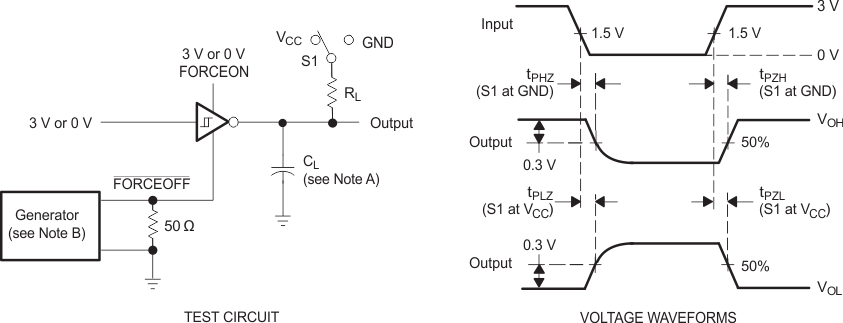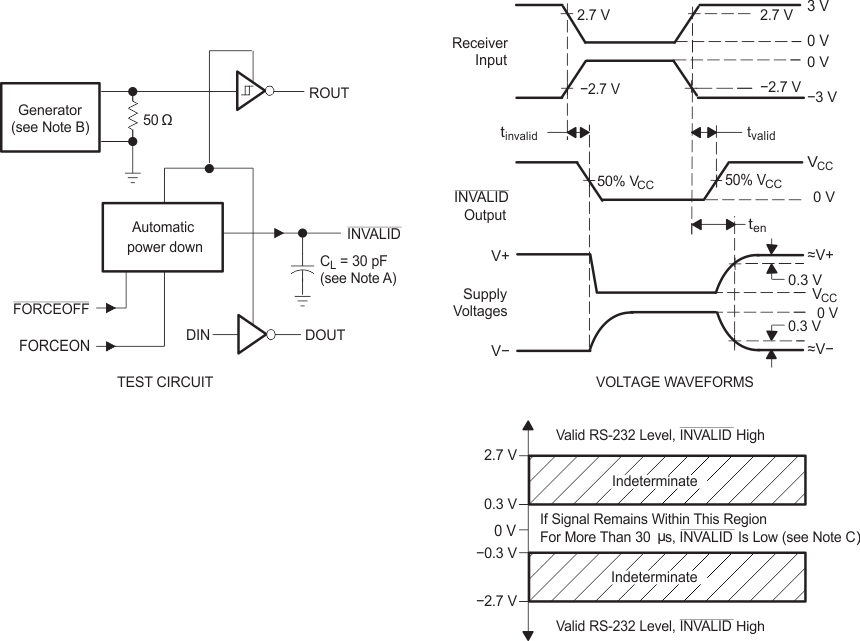SLLS806C June 2007 – October 2022 TRS3243
PRODUCTION DATA
- 1 Features
- 2 Applications
- 3 Description
- 4 Revision History
- 5 Pin Configuration and Functions
-
6 Specifications
- 6.1 Absolute Maximum Ratings
- 6.2 ESD Ratings
- 6.3 Recommended Operating Conditions
- 6.4 Thermal Information
- 6.5 Electrical Characteristics—Power and Status
- 6.6 Electrical Characteristics—Driver
- 6.7 Electrical Characteristics—Receiver
- 6.8 Switching Characteristics—Power and Status
- 6.9 Switching Characteristics—Driver
- 6.10 Switching Characteristics—Receiver
- 6.11 Typical Characteristics
- 7 Parameter Measurement Information
- 8 Detailed Description
- 9 Application and Implementation
- 10Device and Documentation Support
- 11Mechanical, Packaging, and Orderable Information
Package Options
Mechanical Data (Package|Pins)
- DB|28
Thermal pad, mechanical data (Package|Pins)
Orderable Information
7 Parameter Measurement Information

A. CL includes probe and
jig capacitance.
B. The pulse generator has the
following characteristics: PRR = 250 kbps, (MAX3243C/I) and 1 Mbit/s
(MAX3243FC/I), ZO = 50 Ω, 50% duty cycle, tr ≤ 10 ns,
tf ≤ 10 ns.
Figure 7-1 Driver
Slew Rate
A. CL includes probe and
jig capacitance.
B. The pulse generator has the
following characteristics: PRR = 250 kbps, (MAX3243C/I) and 1 Mbit/s
(MAX3243FC/I), ZO = 50 Ω, 50% duty cycle, tr ≤ 10 ns,
tf ≤ 10 ns.
Figure 7-2 Driver
Pulse Skew
A. CL includes probe and
jig capacitance.
B. The pulse generator has the
following characteristics: ZO = 50 Ω, 50% duty cycle, tr ≤
10 ns, tf ≤ 10 ns.
Figure 7-3 Receiver
Propagation Delay Times
A. CL includes probe and
jig capacitance.
B. The pulse generator has the
following characteristics: ZO = 50 Ω, 50% duty cycle, tr ≤
10 ns, tf ≤ 10 ns.
C. tPLZ and
tPHZ are the same as tdis.
D. tPZL and
tPZH are the same as ten.
Figure 7-4 Receiver
Enable and Disable Times
A. CL includes probe and
jig capacitance.
B. The pulse generator has the
following characteristics: PRR = 5 kbps, ZO = 50 Ω, 50% duty cycle,
tr ≤ 10 ns, tf ≤ 10 ns.
C. Automatic power down disables
drivers and reduces supply current to 1 μA.
Figure 7-5 INVALID Propagation Delay Times and Supply Enabling
Time